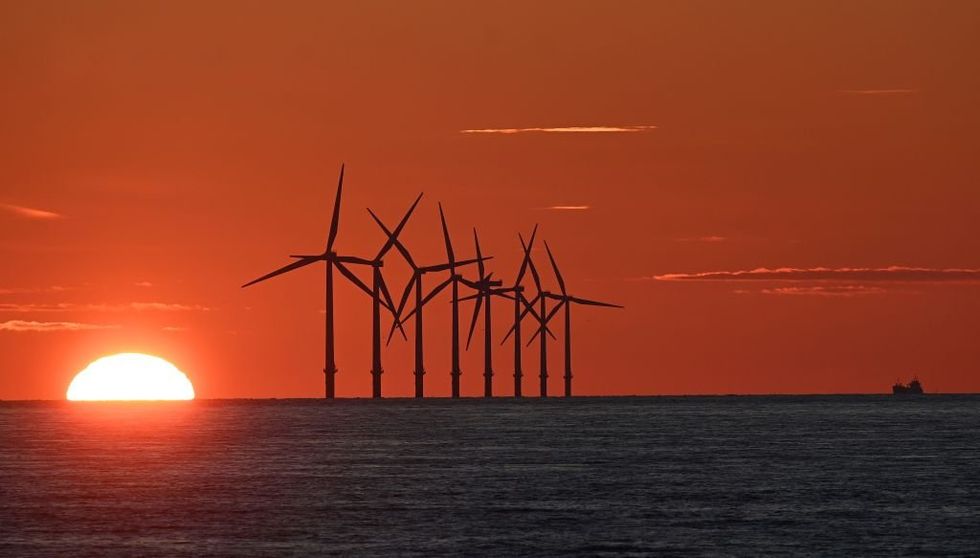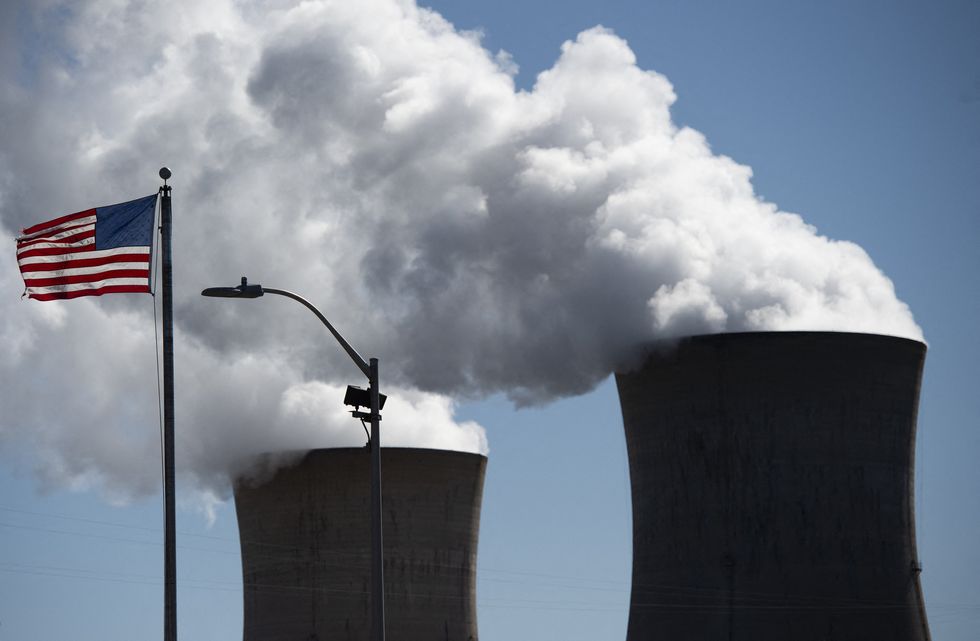
Sean Gallup via Getty Images

In an overlooked congressional hearing last week, Federal Energy Regulatory Commission Commissioner Mark Christie sounded the alarm about the “catastrophic state” of the U.S. energy grid.
Christie opened the hearing by explaining his cause for concern: "The United States is heading for a reliability crisis. I do not use the term 'crisis' for melodrama but because it is an accurate description of what we are facing. I think anyone would regard an increasing threat of system-wide, extensive power outages as a crisis."
'Catastrophic situation': FERC Commissioner Christie warns America's power grid is in big trouble youtu.be
Traditional coal and natural gas power plants are being retired early and at an unsustainable rate, and the new, green power generation resources that are coming online – mainly wind and solar – make the grid less predictable because they vary with weather and sunlight patterns.
“Dispatchable generating resources are retiring far too quickly and in quantities that threaten our ability to keep the lights on. The problem generally is not the addition of intermittent resources, primarily wind and solar, but the far too rapid subtraction of dispatchable resources, especially coal and gas,” Christie explained.
In our rush to go green, we’re reaching a perilous tipping point where our aging grid is straining to keep up with the ever-increasing supply needs for the country. While renewable power sources like wind and solar add much-needed power, they are insufficient to power the grid. The truly green answer, of course, is to build more nuclear plants, and barring that we should at least stop shutting down our coal and gas plants early. As is is, though, the amount of dispatchable power is plummeting, so the country is accelerating toward a cliff.
A recent New York Times article highlighted the situation for many struggling Americans. Rolling blackouts are becoming commonplace for people across the country, and those who can’t afford backup generators and the elderly are particularly at risk for this "new energy normal." This article fails to ask why, in the wealthiest country on earth, with abundant energy resources, citizens have to buy generators to keep the lights on. Spoiler: It's climate change.

In his testimony, Mr. Christie makes it very clear that the issues facing the grid are much more complex than we’ve previously been led to believe. As municipalities integrated more solar and wind options into the grid, we were promised this would make up for the retirement of fossil fuel plants.
However, it’s becoming increasingly clear that these projections fall well short of what is required. Additionally, as more data has come in, the energy produced by renewables appears to be much less efficient.
Renewables often have a lower capacity value than conventional fossil fuel-based power plants such as coal, natural gas, and nuclear power. Capacity value, or capacity credit, measures how much energy a power plant can produce over a given period compared to its maximum potential output.
One of the main challenges associated with renewable energy sources like solar and wind power is their intermittent and variable nature. These “non-dispatchable” energy sources depend on weather conditions and the time of day, which can be unpredictable and inconsistent. For example, solar power generation is limited to daylight hours and is affected by cloud cover, while wind power generation depends on the presence and strength of wind.
In contrast, dispatchable power plants, like those based on fossil fuels or nuclear fission, can produce electricity continuously and consistently as long as they have a steady fuel supply, allowing them to maintain a higher capacity value, as they can operate at or near their maximum output more consistently.
The intermittency and variability of renewable energy sources create a need for energy storage solutions to balance supply and demand. However, large-scale energy storage technologies, such as batteries or pumped hydro storage, are still relatively expensive and have limited capacities, and their production is controlled by the People’s Republic of China.
On the other hand, fossil fuel power plants can store significant amounts of fuel on-site to generate electricity when needed, thereby maintaining a higher capacity value. So as we’re losing vast amounts of energy capacity, it’s being replaced with renewable energy that is much less efficient.
As Christie testified:
Just a few weeks ago, Manu Asthana, the CEO of the PJM regional transmission organization — the largest RTO in the country in terms of consumers served — said that PJM faced the likelihood of losing 40 gigawatts of generation capacity by 2030 through early retirements of generating units. 90% of this retiring capacity is dispatchable generation, primarily coal and gas. Meanwhile PJM faces load growth of an additional 13 gigawatts by 2030. The PJM interconnection queue, however, largely consists of intermittent generation, primarily wind and solar. In terms of capacity value — which is the amount of power that can be supplied to the grid when needed — one nameplate megawatt of wind or solar is simply not equal to one nameplate megawatt of gas, coal, or nuclear. So even if every unit waiting in the PJM interconnection queue was interconnected, that would not solve the reliability problem caused by too-rapid loss of dispatchable generation. The numbers just do not balance.
The ongoing war in the Ukraine has highlighted the precarious energy situation of European member states, especially Germany. For decades Europe has pushed a green narrative increasingly disconnected from the reality of powering a continent. With the highly suspicious destruction of the Nordstream 2, Germany has lost its main natural gas supply from Russia. While the Germans have been scrambling to find alternative sources, including Norway and the U.S., the skyrocketing costs have crippled German industry.
Despite these setbacks, Germany remains committed to its green push, even if it endangers its economy. Last month the country shut down its last nuclear power plant, meaning the German grid will have to survive solely on natural gas and the shifting reliability of renewables. This move confused even environmentalists, who questioned why leaders would shutter a completely clean energy supply in the middle of a war.
Despite a 20-year effort and billions of euros spent, Germany still relies on fossil fuels for over 75% of its energy. Because the Germans have closed their coal and nuclear plants, most of this energy is now imported. Unfortunately, the U.S. is increasingly adopting this same model of planned energy collapse.
As Doomberg points out on Substack: “Given Germany’s multi-year lead in the race to the energy bottom, how events unfold as the implementation of Energiewende enters its final stages will be an instructive case study in the disastrous consequences of pursuing green utopian fantasies.”

The United States power grid is aging and in dire need of upgrades and repairs. This complex network of power plants, substations, and transmission lines ensures electricity is generated and delivered to homes, businesses, and industries nationwide. However, decades of underinvestment and neglect have left the grid vulnerable to failures, cyberattacks, and the increasing demands of a rapidly changing energy landscape.
Much of the grid was built between the 1950s and 1970s, and as a result, many components have reached or exceeded their expected life span. According to the American Society of Civil Engineers, the average age of power transformers in the United States is 40 years, and 70% of the transmission and distribution lines are over 25 years old.
As these components age, they become more susceptible to failures, increasing the likelihood of blackouts and other disruptions. In addition, the outdated design of the grid makes it ill suited to handle the growing demands of a modern, digital society, as well as the increased integration of renewable energy sources. A point brought up by Christie in his testimony. “So even if every unit waiting in the PJM interconnection queue was interconnected, that would not solve the reliability problem caused by too-rapid loss of dispatchable generation.”
Another major factor contributing to the poor state of the U.S. power grid is the lack of sufficient investment in its maintenance and modernization. The ASCE estimates that the U.S. needs to spend $208 billion on the power grid by 2025 to maintain its current performance levels. However, current investment levels are significantly below this target, creating a growing funding gap that will become increasingly difficult to close.
The continued deterioration of the U.S. power grid poses significant risks to the nation's economy, national security, and public health. Persistent underinvestment and neglect could lead to more frequent and severe blackouts, disrupting essential services and causing billions of dollars in economic losses.
Nuclear energy has been a clean, reliable, and sustainable power source since the 1950s. Despite its promising potential to reduce dependence on fossil fuels, the United States has seen a decline in the growth of the nuclear power industry due to a combination of factors, with stringent regulations being one of the most significant.
One of the primary ways that regulations have hindered the growth of nuclear energy in the United States is by imposing an excessive burden on existing nuclear plants. The U.S. Nuclear Regulatory Commission, established in 1974, regulates the nation's civilian use of nuclear materials. While the NRC has played a crucial role in ensuring the safety and security of nuclear power plants, the regulatory burden it imposes has often been criticized as overly burdensome and costly.
Each nuclear power plant in the U.S. must comply with a wide range of regulatory requirements, including safety inspections, security measures, and emergency preparedness plans. While these requirements are essential to protect public health and safety, the cost of compliance can be enormous, often reaching hundreds of millions of dollars per facility. This financial burden has led to the premature closure of several nuclear plants, despite their continued safe and efficient operation.
Moreover, the NRC's cautious approach to new technologies often results in a lengthy and expensive process for obtaining regulatory approval, discouraging investment in innovative nuclear technologies. This has led to a stagnation in the development of advanced reactors, limiting the potential for nuclear power to contribute to a cleaner and more sustainable energy future.
A perfect example is the ongoing cost overruns in the new nuclear power plant in eastern Georgia. It should be noted that this is the only new atomic facility being constructed, and it’s only an expansion of a pre-existing facility.
PJM, the nation’s largest electric grid operator, says it is at risk of losing 21% of its grid capacity by the end of the decade. Theoretically, we could build capacity to make up for these losses. However, with the current untenable regulatory structure and fanatical insistence on green energy solutions, it’s uncertain whether we can make up for this deficit.
We are quickly heading toward a tipping point, where the energy problems seen in Europe and South America will be a part of daily life. The problem is the profoundly unserious nature of the United States government and the solutions it proposes. If the replacement capacity in the queue is entirely renewable, it will fail to provide enough gigawatts of power to keep the lights on. It might be time to invest in a generator.